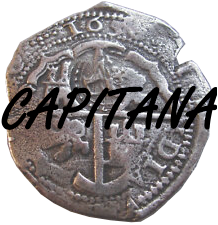La Capitana History
This wreck of the Capitana became the largest loss ever experienced by the Spanish South Seas (Pacific) Fleet, of which the Jesus María de la Limpia Concepción was the Capitana or lead vessel in 1654. The vessel weighed 1,150 tons, was 122 feet long and had a beam of 40 feet. Carrying 60 guns, this was the flagship of the Viceroyalty in Peru. On October 26th, 1654, the pilot, Miguel Benitez, was confident the ship would clear the reefs at Punta Santa Elena and continue on to Isla de Plata. At 11PM that night breakers were spotted, but by that time is was too late to maneuver and by daylight the ship had hit the reef three times and lost its rudder. There was already 8 feet of water in the hold and everyone was exhausted. Later testimony from the crew noted there was difficulty getting the anchors down because there were piles of unregistered cargo stored on the foredeck and on top of the anchor cables. On this dreadful morning people began to panic and some of the wealthier passenger began scheming and paying the boatswain to get them ashore. Some passengers tried loading their pockets with gold and silver and swimming to shore. Twenty people died in their attempt to reach safety. By high tide, Captain Sosa was able to maneuver the Capitana closer to shore and ground her in shallow water. For greater access to the treasure and other valuables below deck, they burned the ship to the water line.
Official records reported the loss of 3,000,000 pesos of silver, augmented to a total of as much as 10 million pesos when contraband and private consignments were taken into account. By comparison, the entire annual silver production in Peru at that time was only about 6-7 million pesos. This implies that the Concepcion was carrying almost 1½ years of production by the Spanish!
For eight years afterward, Spanish salvagers officially recovered over 3,000,000 pesos of coins and bullion. Captain Sosa recovered 1,500,000 Pesos and a later salvor recovered another 2,000,000 pesos. This caused a major scandal because only 3,000,000 pesos were recorded to be on board the ship. Later estimates put that total around 10,000,000. Ironically, the main salvager of the Capitana in the 1650s and early 1660s was none other than the ship’s silver master, Bernardo de Campos, whose fault it was that the ship was overloaded with contraband in the first place! The unreachable lower section held on to the remaining treasure for divers to find in our time.
The wreck was rediscovered in the mid-1990s and salvaged (completely, according to some) in 1997. After a 50-50 split with the Ecuadorian government in 1998, investors placed most of their half of the more than 5,000 coins recovered up for sale at auction in 1999. Almost exclusively Potosí 8 and 4 Reales, the coins were a healthy mix of countermarked issues of 1649-1652 (figure 1), transitional issues of 1652 (figure 4), and post-transitional pillars-and-waves cobs of 1653-1654 (figure 3). Many of these coins where in excellent condition and expertly conserved.
As an interesting historical footnote, the coins salvaged from the Capitana by the Spanish in 1654 were sent to Cuba and reloaded on to another Galleon; The Nuestra Senora del la Maravilla. Still the story continues when the Maravillas subsequently sank on January 4, 1656. The story of these shipwreck coins, that have already survived two shipwrecks, ends when the third salvage vessel the “Madama do Brasil”, sank off Gorda Cay (Bahamas) in 1657 carrying the treasure salvaged from the Maravilla. Furthering Spain’s woes was the destruction of another treasure fleet in 1657 by English marauders (fresh off a victory in the Bay of Cádiz) off Santa Cruz on the island of Tenerife in the Canary Islands. The loss of the Capitana was a major financial hit to the Spanish Crown, already heavily in debt from expansion by its Monarchs. This was part of the beginning of the end for Spain on the world stage.
The Coins of the Capitana: In 1996 Captain Hermon Moro and his crew discovered the Capitana. Their final negotiation with the country of Ecuador granted them half the treasure, which netted investors about 2,500 coins. Records show that the majority of the coins were presented at auction in 1999. During this time, it was discovered that most of these coins had a unique stamp that had been added after the coin had been minted. For you to truly understand this coin’s unique history, we will start this story at the Potosi mint in 1649. It was a turbulent time for the Spanish Monarch, King Philip IV. The integrity of Spanish Silver had been dropping globally for years when suddenly major trading powers such as China refused to accept Spanish Pesos for trade. The King sent a royal investigator, Don Francis de Nestares Marin to discover the problem at the mints in Peru. What Marin found was widespread fraud that extended from the Assayers all the way up to the Mining officials. The three Assayers Ramirez Arellano (A), Pedro Zambrano (Z), and Geronimo Velazquez (V) were found guilty and either executed or sent to prison. Coins from these Assayers are very rare. Two new Assayers where assigned in 1649, Rodriquez de Roads (O with a dot in the center), and his assistant Antonio Ovando (O). Both of these assayers were replaced because of corruption in 1651 by Antonio de Ergueta (E). Ergueta worked at the mint for the next 30 years.
In response to this nefarious fraud; in 1650 King Philip IV declared that all ½, 1 and 2 Reales coins to be withdrawn from circulation to be melted, which explains why these are rarely seen. The 8 and 4 Reales coins were devalued. Coins prior to 1649 where devalued to six (6) and three (3) Reales. The rest of the coins from this period where melted. 8 and 4 Reales coins from 1649 to 1651 were devalued to 6 ½ and 3 ¾ Reales respectively. The Viceroy at the Potosi mint then ordered these devalued coins be “Crown Marked” (counter stamped) to legitimize them for trade. What history has given us is an unprecedented variety of hand struck Spanish Cobs unlike any other during the more than 300 years the Spanish minted coins. These unique coins show us the turmoil and uncertainty caused by the infamous fraud at the Potosi Mint, and another fall in Spain’s financial dominance as a world power.
So far about 40 different counterstamps have been documented, but not totally understood (about 19 from the Capitana). On all silver coins from 1649 to 1653, Spain is using a counterstamp to indicate full or fair value of the coins (figure 1). Most of the coins show unique cracks from the counter stamping process (figure 2). In 1652 the King ordered a new coin design to regain credibility (figure 3) and you see this new Pillar and Wave design on the coin in (figure 4); which also shows the initial design for the Pillar and Wave, however minting on this design stopped in favor of the design in (figure 3).
We believe these intriguing coins from the Capitana can be joined with your personal taste in designing your very own “Key West Dog Tag”. This a very rare collection of Shipwreck coin with plenty of individuality, just like you. Take a look at our Capitana collection and start your journey right now! All of our coins come with a certificate of authenticity.

(figure 1) Almost exclusively Potosí 8 and 4 Reales, the coins were a healthy mix of countermarked issues of 1649-1652. This coin is dated 1649 and has the Crown over “L” countermark on the cross side. King Philip decreed that all 1 and 2 Reales coins be returned and be melted down.

(figure 2) This 1651 dated coin was one of the last “cross and shield” design Potosi minted silver coins and it bears the “Crown” countermark on the shield side. By 1652, Spain would have started the transition to the Pillar and Wave design.

(figure 3) This is one of this first Pillar and Wave designs transitional coins under King Philip IV. This coin is rare 2 Reales coin dated 1652.

(figure 4) This Pillar and Wave design was struck for less than 11 months, before another design was chosen to mint. It was often referred to as an 8 over 8 design.

